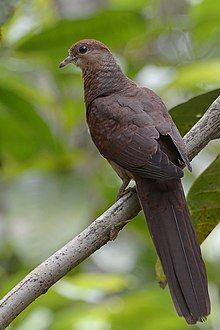
Reinwardtoena is a small genus of doves in the family Columbidae. They are found on parts of Indonesia, Papua New Guinea and the Solomon Islands.
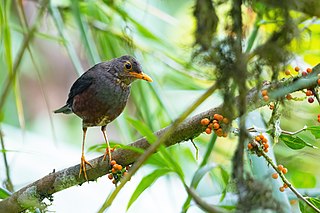
The island thrush is a common forest bird in the thrush family. Almost 50 subspecies have been described, ranging from South East Asia and Melanesia, to Samoa, exhibiting great differences in plumage. Several subspecies are threatened and three have already become extinct.

The Amboyna cuckoo-dove is a dove in the genus Macropygia found in the Moluccas and New Guinea. It was one of three new species defined when the slender-billed cuckoo-dove was split up in 2016 and retains the Latin binomial of the former species.[1]
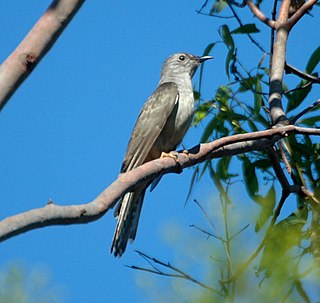
The brush cuckoo is a member of the cuckoo family.

Blyth's hornbill, also known as the Papuan hornbill, is a large hornbill inhabiting the forest canopy in Wallacea and Melanesia. Its local name in Tok Pisin is kokomo.

The lesser coucal is a species of cuckoo in the family Cuculidae. It has a wide distribution range that overlaps with several other similar species. The habitat in which it is found is often marshy land with grass and tree cover. It is distinguished by its smaller size, less prominent bill, pale shaft streaks on the feathers of the head and back. It has a much longer claw on its hind toe and a distinct call. It is also among the few coucals that show season plumage differences but like in other coucals, the sexes cannot be distinguished in the field.
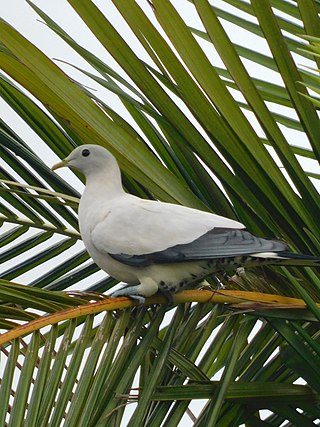
The Torresian imperial pigeon, also known as the nutmeg pigeon, white nutmeg pigeon, Australian pied imperial pigeon or Torres Strait pigeon, is a relatively large, pied species of pigeon. It is found in forest, woodland, savanna, mangrove and scrub in Australia, New Guinea, Aru Islands, islands in the Geelvink Bay, D'Entrecasteaux Islands and Louisiade Archipelago.

The ruddy cuckoo-dove is a species of bird in the family Columbidae. It is a medium-sized, reddish brown cuckoo-dove, found in Brunei, Indonesia, and Malaysia. It is rated as a species of least concern on the International Union for Conservation of Nature Red List of Endangered Species.

Macropygia is a genus of bird in the pigeon and dove family Columbidae. The genus is one of three genera known as cuckoo-doves. They are long tailed, range between 27 and 45 cm in length and have brown plumage. The genus now ranges from India and China through Indonesia and the Philippines to Vanuatu and Australia, though they originated from North and South America.

Mackinlay's cuckoo-dove, also known as the spot-breasted cuckoo-dove, is a species of bird in the family Columbidae. It is found in Papua New Guinea, Solomon Islands, and Vanuatu. It is rated as a species of least concern on the International Union for Conservation of Nature Red List of Endangered Species.
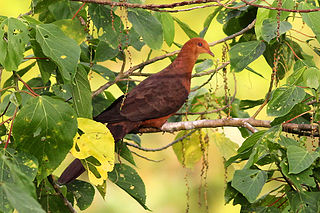
The Philippine cuckoo-dove is a species of bird in the family Columbidae. It is found in the Philippines and Taiwan and is rated as a species of least concern on the International Union for Conservation of Nature Red List of Endangered Species.

The pied cuckoo-dove is a species of bird in the pigeon family, Columbidae. First described by English zoologist Philip Sclater in 1877, it is endemic to the Bismarck Archipelago, where it mainly inhabits lowland and hill forests at elevations of up to 1,000 m (3,300 ft). It is a large, distinctive pigeon, with a length of 40–46 cm (16–18 in) and a weight of 279–325 g (9.8–11.5 oz). Adults are mainly black and white. The heads and underparts are whitish, while the wings, tails, and upperparts are black. Both sexes look alike. Juveniles are mainly sooty-grey in colour.

The great cuckoo-dove is a species of bird in the pigeon family, Columbidae. First described by the Dutch zoologist Coenraad Jacob Temminck in 1824, it is found on New Guinea, several surrounding islands, and Wallacea, where it mainly inhabits primary forest and forest edge. It is a large, distinctive pigeon, with a length of 47.5–52.5 cm (18.7–20.7 in) and a weight of 208–305 g (7.3–10.8 oz). In adults, the head, neck, and breast are whitish or blue-grey, the underparts are pale bluish-grey, the upperparts are chestnut-brown, and the outer wings are black. Females differ from males in having more yellowish irises and duller orbital skin. Juveniles are mainly dull grey-brown, with dirty-white throats and bellies.

The island monarch is a species of bird in the family Monarchidae. It is found from Sulawesi to the Solomon Islands. Its natural habitats are subtropical or tropical moist lowland forests and subtropical or tropical moist montane forests.

The yellow-throated whistler or Banda Sea whistler, is a species of bird in the family Pachycephalidae. It is endemic to central and south-eastern Wallacea, where it ranges from Timor east to the Tanimbars and north to Seram and Banggai. The oriole whistler is sometimes alternatively called the yellow-throated whistler, leading to confusion between both species.

The brown cuckoo-dove is a dove in the genus Macropygia found in Australia from Weipa and Aurukun in the north to Bega in the south, and most inland at Atherton and Toowoomba. It is sometimes called the "brown pigeon" or "pheasant pigeon", but both terms are best avoided, as they can lead to confusion with the brown doves and the true pheasant pigeon. It was one of three new species defined when the slender-billed cuckoo-dove was split in 2016.
The Flores Sea cuckoo-dove is a species of bird in the family Columbidae. It is found on Sulawesi, Tanakeke and Selayar Islands, and some of the eastern Lesser Sundas. It was previously lumped together with the Tanimbar cuckoo-dove and the Timor cuckoo-dove as the dusky or bar-necked cuckoo-dove. The Flores Sea cuckoo-dove has two subspecies:
The Enggano cuckoo-dove is a species of bird in the family Columbidae. It is endemic to Enggano Island in Indonesia. Until 2016, it was considered a subspecies of the ruddy cuckoo-dove.

The Barusan cuckoo-dove is a species of bird in the family Columbidae. It is found on three of the western Sumatran islands.
The slender-billed cuckoo-dove was until recently the name of a species of bird in the family Columbidae. Its range covered Brunei, Indonesia, Malaysia, Papua New Guinea and northern Australia. The binomial M. amboinensis now refers to the Amboyna cuckoo-dove. The taxonomy of the slender-billed cuckoo-dove was complex, but most authorities now split it into four species based on analyses of vocalizations. This will be further refined by future genetic analyses.
